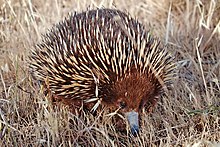
Back نضناض قصير المنقار Arabic ذو المنقار القصير الايكى دنا ARZ Akangol (Tachyglossus aculeatus) AVK Avstraliya yexidnası Azerbaijani Същинска ехидна Bulgarian Ekidne pigos berr Breton Equidna de musell curt Catalan Tachyglossus aculeatus CEB ᎡᎳᏗᏝ ᏙᏒᏓᎵ ᏗᎦᏰᏍᎩ CHR Ježura australská Czech
| Short-beaked echidna[1] | |
|---|---|

| |
| Scientific classification | |
| Domain: | Eukaryota |
| Kingdom: | Animalia |
| Phylum: | Chordata |
| Clade: | Synapsida |
| Class: | Mammalia |
| Order: | Monotremata |
| Family: | Tachyglossidae |
| Genus: | Tachyglossus Illiger, 1811 |
| Species: | T. aculeatus
|
| Binomial name | |
| Tachyglossus aculeatus (Shaw, 1792)
| |

| |
| Short-beaked echidna range | |
The short-beaked echidna (Tachyglossus aculeatus) is the only member of its genus, and one of four living species of echidna.
The short-beaked echidna, Tachyglossus, is the spiny anteater because they eat ants and termites. It is covered in fur and spines. It has a special nose (snout) and a special tongue that lets the echidna catch its prey at a great speed. It lays eggs, like the other monotremes.
The echidna lives throughout Australia, and in coastal and highland regions of southwestern New Guinea.[3] In Australia, it is the most widespread native mammal. It is not threatened with extinction, but human activities, such as hunting, habitat destruction, and the introduction of foreign predators and parasites, have reduced its range.
- ↑ Groves, C.P. (2005). "Order Monotremata". In Wilson, D.E.; Reeder, D.M (eds.). Mammal Species of the World: A Taxonomic and Geographic Reference (3rd ed.). Johns Hopkins University Press. p. 1. ISBN 978-0-8018-8221-0. OCLC 62265494.
- ↑ Aplin, K.; Dickman, C.; Salas, L.; Helgen, K. (2016). "Tachyglossus aculeatus". IUCN Red List of Threatened Species. 2016. IUCN: e.T41312A21964662. doi:10.2305/IUCN.UK.2016-2.RLTS.T41312A21964662.en. Retrieved 23 April 2017.
- ↑ Flannery T. 1990. Mammals of New Guinea Robert Brown. ISBN 1-86273-029-6
